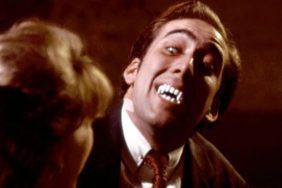Welcome back to The Series Project, my dear blood slaves, and the second week of the Hammer Dracula films therein. Are you sitting comfortably? Then we’ll begin.
As we round the corner into the 1970s, we can vaguely detect the lurid odors of Hammer Studio’s trashy reputation beginning to manifest themselves. This week we’ll be covering the fourth, fifth, and sixth Hammer Dracula films (specifically Dracula Has Risen from the Grave as I suppose he must, the deliciously titled Taste the Blood of Dracula, and the pretty rote Scars of Dracula). In these films, we’ll see a noticeable uptick in the frequency of erotically heaving bosoms, bloodied deaths, and even a few instances of nudity.
Hammer films, I am learning, exist in a strange netherrealm that lies at the exact midpoint between totally trashy schlock (akin to a lot of the Italian Euroschlock films of the time) and well-worn horror classicism (akin to the Universal Monster film from a generation previous). Dracula himself (played by Christopher Lee in all of these films) is still an imposing, spooky aristocrat in most of the films, and the movies all bank on the mythic horror imagery of misty castles in remote places, all in the just-distant-enough past.
Although those mythic qualities will diminish considerably for the seventh film in the series, Dracula AD 1972, often considered the worst in the series, but we’ll not get to that one until next week.
But whether or not they are trashy or classy, it cannot be argued that they are all possessed of an unquenchable brio. However cheap they may have been, there seemed to be a mite of actual passion behind each of the Hammer Dracula movies. Especially when they hired well-known bonkers directors like Freddie Francis to make the first film of the week…
Dracula Has Risen from the Grave (dir. Freddie Francis, 1968)

Freddie Francis is known to cult film aficionados as the master behind movies like Dr. Terror, The Creeping Flesh, and the totally off-the-wall Son of Dracula (which starred Ringo Starr and Harry Nilsson). You may also know him as David Lynch’s cinematographer, or the Oscar winner who shot Glory. This man is a professional.
So it’s pleasing to watch an early bugnuts director-for-hire camp job like Dracula Has Risen from the Grave in his wheelhouse. Like the previous films in the Hammer Dracula series, From the Grave is a lurid romance novel with the usual tropes: Dracula strangles a guy, Dracula has two slaves, a heroic holy man kills off Dracula, and the collective cleavage on display can be measured in meters.

The story is more complicated than usual (we’re wandering afield of the “Van Helsing is Awesome” story and the Old Dark House story), so I’ll boil it down as well as I can. Following the events of Dracula: Prince of Darkness, a local Monsignor (Rupert Davies) decides to clean house, so to speak, and out-and-out exorcize Dracula’s castle; the locals are still afraid of the place, you see. Dracula (Lee) is still frozen under the ice, and is reawakened when an ancillary priest trips on the frozen lake, cuts his hand on the ice, and a dribble of his blood leaks into Dracula’s mouth. That’s all it takes.

Maria is betrothed to a dashing student named Paul (Barry Andrews) a guy who knows nothing about Dracula, or even about religion for that matter; he proclaims that he is an atheist. Poor Maria is understandably torn between the opposing theological viewpoints of her father and her lover. Paul’s lack of religion, however, makes him a more interesting hero, as Dracula can only be killed (at least in this movie) by both a stake and a prayer. When a fellow who doesn’t pray stakes Dracula, it doesn’t quite work. Paul does eventually find faith, though, when the evil is overcome. I guess the themes of most Dracula stories is ultimately about the triumph of hope and purity over appetite and death. Thus, I suppose it’s appropriate to address theology so directly (if not bluntly).

Dracula is eventually staked by a cross, and he bleeds out of his eyes. His body disintegrates into a pile of red powder. Dracula powder. Get this: For all the having chests and bloody stakings (there are two stakings in the film), Dracula Has Risen from the Grave is rated G. Yeah, don’t show this film to little kids. True, this was before the PG-13 rating (indeed, 1968 was when the rating system was just unveiled), but I would assume this would at least get a GP rating (the early version of PG).
And that powder? Wanna find out what happens when you eat Dracula powder?








